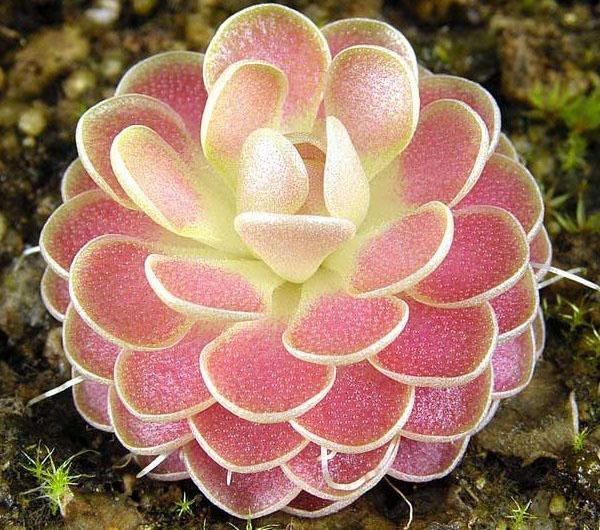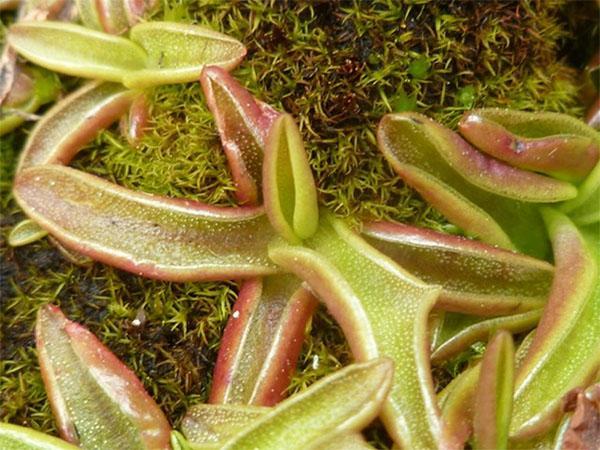An unusual houseplant from the genus of insectivores - Zhiryanka
 Zhiryanka is an insectivorous perennial plant that belongs to the Pemphigus family (Lentibulariaceae). Despite the fact that this is a predatory flower, it is often grown indoors. However, it is difficult to call Zhiryanka a decorative culture. Its use in the interior is rather exotic. Popularly, this unusual indoor flower is often called oil grass.
Zhiryanka is an insectivorous perennial plant that belongs to the Pemphigus family (Lentibulariaceae). Despite the fact that this is a predatory flower, it is often grown indoors. However, it is difficult to call Zhiryanka a decorative culture. Its use in the interior is rather exotic. Popularly, this unusual indoor flower is often called oil grass.
Zhiryanka: photo and general description

How to feed the plant?
 Zhiryanka is an insectivorous plant, therefore, feeding should be appropriate. It should be fed exclusively by insects. To do this, just put a small piece of sweet fruit (you can melon) next to the flower. In a short period of time, small Drosophila will flock to it. However, many experts urge not to feed the plant on purpose. Under suitable conditions, the flower will independently find its "food" by catching a midge.
Zhiryanka is an insectivorous plant, therefore, feeding should be appropriate. It should be fed exclusively by insects. To do this, just put a small piece of sweet fruit (you can melon) next to the flower. In a short period of time, small Drosophila will flock to it. However, many experts urge not to feed the plant on purpose. Under suitable conditions, the flower will independently find its "food" by catching a midge.
How is insect catching?
 Zhiryanka has delicate flowers that resemble violet inflorescences. Leaves of a bright light green shade, together form a basal rosette. It is the only plant of its kind that has true roots. Its name comes from the word "pinguis", which means "bold". This name is due to the presence of fleshy, succulent leaves that have a shiny surface. It contains many tiny glands that secrete a secret in the form of mucus.
Zhiryanka has delicate flowers that resemble violet inflorescences. Leaves of a bright light green shade, together form a basal rosette. It is the only plant of its kind that has true roots. Its name comes from the word "pinguis", which means "bold". This name is due to the presence of fleshy, succulent leaves that have a shiny surface. It contains many tiny glands that secrete a secret in the form of mucus.
First of all, sugar is formed on the leaves in order to attract insects, and then digestive enzymes for their digestion. If the “victim” is small enough, then the plant is limited by the sticking effect. If a larger prey is caught, then the fatty plant can fold its leaf, but not as pronounced as it happens with the sundew.
Watering process and air humidity
 As with all carnivorous plants, watered with distilled water from the pan. Unlike other species, it is quite unpretentious and can even put up with rainwater. In extreme cases, tap water will do. But if you want the plant to thrive, it is best to avoid water with this composition. Watering must necessarily be bottom, from the pallet, otherwise the flower may die. In summer, watering frequency is every 2 days. In winter, watering can be reduced to once a week.
As with all carnivorous plants, watered with distilled water from the pan. Unlike other species, it is quite unpretentious and can even put up with rainwater. In extreme cases, tap water will do. But if you want the plant to thrive, it is best to avoid water with this composition. Watering must necessarily be bottom, from the pallet, otherwise the flower may die. In summer, watering frequency is every 2 days. In winter, watering can be reduced to once a week.
The humidity in the room should vary between 40-75%.
Very low moisture readings can be detrimental. In general, the plant thrives in the terrarium as well, as it prefers a humid atmosphere. The only thing that should be strictly avoided is spraying the plant, since mucus is constantly produced on its leaves, which is necessary for the nutrition process.
It is strictly forbidden to rinse the flower under the shower or carry out any other procedure in which water gets on the leaves.
Location and lighting
 Fatty plants are able to grow normally even in poor natural light. For the flower to develop correctly, it will be enough just 3 hours a day to leave it under intense sunlight. It is advisable to do this in the evening or in the morning. Daytime ultraviolet light will already have a negative effect. The most optimal growing environment is window sills in the western or eastern part of the house. The plant tolerates the heat worst of all in summer, so this crop is often grown in florariums where lighting devices are installed. Deep shade is also not the best condition for a fat woman, but in partial shade it will feel comfortable.
Fatty plants are able to grow normally even in poor natural light. For the flower to develop correctly, it will be enough just 3 hours a day to leave it under intense sunlight. It is advisable to do this in the evening or in the morning. Daytime ultraviolet light will already have a negative effect. The most optimal growing environment is window sills in the western or eastern part of the house. The plant tolerates the heat worst of all in summer, so this crop is often grown in florariums where lighting devices are installed. Deep shade is also not the best condition for a fat woman, but in partial shade it will feel comfortable.
Transplant and substrate
 The most successful substrates are acidic, with a classic composition. It should be noted that the soil must be mandatory for predatory crops. It could be a mixture of peat and perlite. Instead of perlite, coarse sand or other additional components for the substrate are also suitable. The transplant process is extremely simple. To do this, it is enough to remove the flower from the soil along with the lump, and then remove the substrate from the root system. After that, a small depression is made in a pot completely filled with a new earthen mixture. This predatory flower is installed in it. The finishing touch is watering with suitable water.
The most successful substrates are acidic, with a classic composition. It should be noted that the soil must be mandatory for predatory crops. It could be a mixture of peat and perlite. Instead of perlite, coarse sand or other additional components for the substrate are also suitable. The transplant process is extremely simple. To do this, it is enough to remove the flower from the soil along with the lump, and then remove the substrate from the root system. After that, a small depression is made in a pot completely filled with a new earthen mixture. This predatory flower is installed in it. The finishing touch is watering with suitable water.